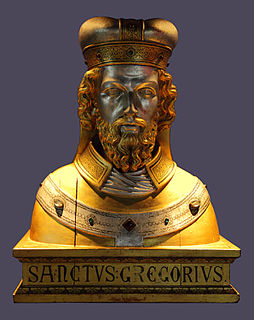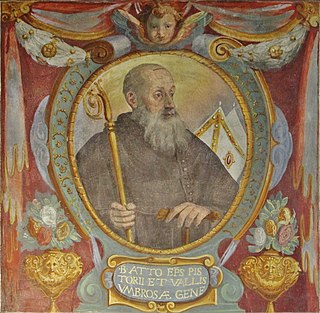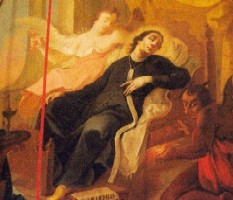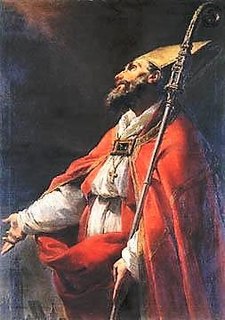
Marculf (in French Marcoult, Marcouf, Marcoul or Marcou) (d. 558) [1] was the abbot at Nantus in the Cotentin. He is regarded as a saint and is associated with the healing of scrofula. [2]

Marculf (in French Marcoult, Marcouf, Marcoul or Marcou) (d. 558) [1] was the abbot at Nantus in the Cotentin. He is regarded as a saint and is associated with the healing of scrofula. [2]
Marculf was born in the Saxon colony of Bayeux around AD 500. The accounts of his life are merged with that of Saint Helier, whom he sent to convert the inhabitants of Jersey to Christianity. Marcouf also visited Jersey himself, where miracles are ascribed to him.
He died on May 1, 558, in the Îles Saint-Marcouf off the east coast of the Cotentin Peninsula. His relics were transferred to the abbey of Corbény in Champagne, where they played a part in the coronation ceremonies of kings of France, crowned at Reims, and in the tradition of the royal touch.
The traditional power ascribed to French and English kings to cure scrofula (the king's Evil) by the laying on of hands derives from the efficacy of the relics of Marcouf, according to the chronicle of Joan of Arc, Chronique de la Pucelle . [3]
The north ambulatory of the Cathédrale Notre-Dame de Coutances contains the Chapel of Saint Marcouf, with a stained glass window showing scenes from the saint's life.
There are communes that have the name "Saint-Marcouf" in Normandy, France.

Saint Helier was a 6th-century ascetic hermit. He is the patron saint of Jersey in the Channel Islands, and in particular of the town and parish of Saint Helier, the island's capital. He is also invoked as a healing saint for diseases of the skin and eyes.

Gregory of Utrecht was born of a noble family at Trier. He became a follower of Saint Boniface, who sent him to study at the Monastery of Saint Michael at Ohrdruf. He then accompanied Boniface on his missionary journeys. In 750, Boniface appointed Gregory abbot of St. Martin's Monastery in Utrecht. St. Martin's became a centre of learning and missionary activity. When, in 754, Eoban left to accompany Boniface on their last missionary trip, Gregory was tasked with administering the diocese of Utrecht, which he did faithfully for the next twenty-three years until his death in 776.

Saint Wendelin of Trier was a hermit and abbot. Although not listed in the Roman Martyrology, his cultus is wide-spread in German-speaking areas. He is a patron of country folk and herdsmen. He is honored on October 22.

Fructuosus of Braga was the Bishop of Dumio and Archbishop of Braga, a great founder of monasteries, who died on 16 April 665. He was the son of a Visigothic dux in the region of Bierzo and at a young age accompanied his father on official trips over his estates. After a period spent as a hermit, he established a monastery at Complutum and became its first abbot.

Atto of Pistoia: Santo Atão; c. 1070 – 22 May 1153) was a Catholic bishop and a professed member from the Vallumbrosan Order as well as the Bishop of Pistoia and a noted historiographer.

William of Æbelholt was a French-born churchman of Denmark.

Saint Petronius was bishop of Bologna during the fifth century. He is a patron saint of the city. Born of a noble Roman family, he became a convert to Christianity and subsequently a priest. As bishop of Bologna, he built the Church of Santo Stefano.
Odo of Glanfeuil was a ninth-century Benedictine abbot of Saint-Maur-des-Fossés, a historian, and hagiographer.

Saint Mesmin is a French saint associated with the Bishopric of Orléans. He was the second abbot of Micy Abbey, founded by his uncle, Saint Euspicius.

Germaine Cousin, also Germana Cousin, Germaine of Pibrac, or Germana, (1579–1601) is a French saint. She was born in 1579 to humble parents at Pibrac, a village 15 km (9.3 mi) from Toulouse.

Humbert of Maroilles was a Frankish monk, abbot, and saint. He founded Maroilles Abbey.

Saint Hervé, also known as Harvey, Herveus, or Houarniaule, was a sixth-century Breton saint. Along with Saint Ives, he is one of the most popular of the Breton saints. He was born in Guimiliau (Gwimilio).
Cyril of Constantinople was reputed to have been a Prior General of the Carmelites and prior of the hermits on Mount Carmel for three years. He is said to have had the gift of prophecy.
Saint Remaclus was a Benedictine missionary bishop.

Saint Gérard founded Brogne Abbey and reformed eighteen others according to the Benedictine Rule.
Saint Taurinus of Évreux, also known as Saint Taurin, is venerated as a saint by the Catholic Church. His legend states that he was the first bishop of Évreux. He evangelized the region and died a martyr.
Adalbert I of Ostrevent was a 7th-century Frankish nobleman of the court of King Clovis II of France. He is recognized as a saint, and is commemorated on both 2 February and 2 May.

Saint Turiaf of Dol was a Breton abbot and bishop of the ancient Diocese of Dol.
Saint Mommolin of Noyon was a monk who became an abbot in Saint-Omer, then Bishop of Noyon-Tournai in Belgium. His feast day is 16 October.

Saint Babolen was Abbot of Saint-Maur-des-Fossés Abbey near Paris. He may have been Irish in origin. His feast day is 26 June.